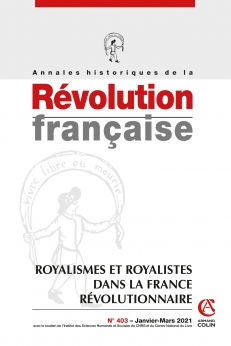
ANNALES HISTORIQUES DE LA RÉVOLUTION FRANÇAISE Nº403 (1/2021)
Pour acheter ce numéro, contactez-nous
Recevez les numéros de l'année en cours et accédez à l'intégralité des articles en ligne.
À partir de l’analyse d’une affiche, Le Chant du Coq, cet article étudie l’engagement royaliste dans l’espace public parisien au cours des premières années de la Révolution. Dans la période charnière qui s’ouvre en juin 1791 avec la fuite et l’arrestation du roi, Le Chant du Coq est un outil permettant de discréditer les adversaires des royalistes présents à l’Assemblée. Au sein de la campagne médiatique mise en oeuvre pour soutenir les intérêts du roi, l’affichage constitue un médium central, abondamment diffusé et associé aux libelles et à la presse. Cible privilégiée de l’activisme jacobin, que ce soit dans les journaux ou à travers les veilles civiques pour arracher l’affiche, Le Chant du Coq fait apparaître les efforts des royalistes pour s’adapter aux nouvelles formes médiatiques permettant de mobiliser l’opinion et d’occuper l’espace public. Il met également en évidence les ambivalences de la communication des monarchistes constitutionnels en 1791, ancrée dans une zone grise mélangeant valeurs royalistes et principes républicains.
Based on the analysis of a poster, Le Chant du Coq, this article studies the royalist engagement in the Parisian public space during the first years of the Revolution. In the pivotal period beginning in June 1791 with the king’s flight and arrest, Le Chant du Coq was a means for discrediting the opponents of the royalists present in the Assembly. Part of the media campaign implemented to support the interests of the king, the poster constituted a central medium, widely distributed and associated with the libels and the press. A privileged target of Jacobin activism, whether in newspapers or through civic vigils to tear down the poster, Le Chant du Coq highlights the efforts of the royalists to adapt to new media forms to mobilize opinion and occupy public space. It also underscores the ambivalence of the communication of constitutional monarchists in 1791, embedded in a grey zone mixing royalist values and republican principles.